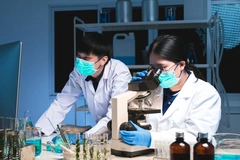Berry health benefits open up new options for cancer treatment
05 Apr 2018 --- Naturally occurring pigments in berries, also known as anthocyanins, increase the function of the sirtuin 6 enzyme in cancer cells, a new study from the University of Eastern Finland shows. The regulation of this enzyme could open up new avenues for cancer treatment. The findings were published in Scientific Reports.
Sirtuins are enzymes regulating the expression of genes that control the function of cells through key cellular signaling pathways. Aging causes changes in sirtuin function, and these changes contribute to the development of various diseases. Sirtuin 6, or SIRT6 for short, is a less well-known enzyme that is also linked to glucose metabolism.
Berries get their red, blue or purple color from natural pigments, anthocyanins.


and decrease cancer genes TWIST1 (B) and GLUT1 (C) protein on human colorectal cancer cells.
“The most interesting results of our study relate to cyanidin, which is an anthocyanin found abundantly in wild bilberry, blackcurrant and lingonberry,” says Minna Rahnasto-Rilla, Doctor of Pharmacy, the lead author of the article.
“This study explores that natural pigments of berries increase SIRT6 activity in colorectal cancer cells. Sirtuins regulate for example gene expression and repair DNA damage. Among sirtuins SIRT6 is less studied. SIRT6 was observed selectively downregulated in several human cancer cells particularly in pancreatic and colorectal cancer cells,” Rahnasto-Rilla tells NutritionInsight.
According to the researchers, there is considerable evidence that SIRT6 is a tumor suppressor and thus SIRT6 activation or increased expression may protect against cancer. This study also showed that pigments in berries also decrease the expression levels of genes that are associated with the risk of getting cancer.
“This study shows for the first time a proof of activation of SIRT6 with natural compounds from berries,” Rahnasto-Rilla says. “The study provides novel knowledge that can be eventually used in preventing or curing of a particular cancer. The knowledge obtained will open up avenues for broad variety of different therapeutic areas to which SIRT6 are linked to, such as cancer and Type 2 diabetes. This study provides also a starting point developing new natural compounds targeting the epigenetic regulation of gene function.”
The researchers also designed a computer-based model that allowed them to predict how different flavonoid compounds in plants can regulate the SIRT6 enzyme.
Working at the School of Pharmacy of the University of Eastern Finland, the Sirtuin Research Group studies whether anthocyanins found in berries could activate SIRT6 function and, consequently, reduce the expression of cancer genes and cancer cell growth. The group also develops new compounds targeting the epigenetic regulation of gene function.
The Finnish-American study included researchers from the University of Eastern Finland and the National Institute on Aging in the US. The study was funded by the Academy of Finland, the Finnish Cultural Foundation, and the US National Institute of Health.
One of the aims for future studies, Rahnasto-Rilla tells NutritionInsight, will be uncovering whether the way the berries are cultivated impacts their health benefits.
by Lucy Gunn















